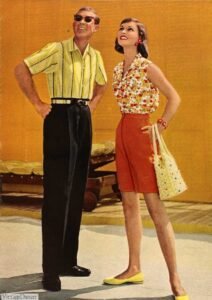Accessories and Accoutrements in 1950s Fashion
Hats
Hats were a popular accessory in the 1950s for both men and women. Women wore a variety of styles, including pillbox hats, wide-brimmed hats, and fascinators, often adorned with ribbons, flowers, or veils. Men commonly wore fedoras or trilbies, adding a polished touch to their outfits.
Gloves
Gloves were an essential accessory for women in the 1950s, symbolizing elegance and sophistication. They were worn for both day and evening events, coming in various lengths from wrist to elbow. Common materials included cotton, leather, and satin.
Jewelry
Jewelry in the 1950s was bold and stylish. Women favored pearl necklaces, brooches, and clip-on earrings. Costume jewelry made from colorful plastic and rhinestones became widely popular, offering an affordable way to accessorize outfits.
Handbags and Purses
Handbags were a key accessory for women, often matching their outfits in color and style. Popular styles included structured handbags with short handles and clutch purses for evening wear. Materials ranged from leather to fabric, often embellished with decorative details.
Key Figures and Influences in 1950s Fashion
Christian Dior
Christian Dior was a major influence in 1950s fashion with his introduction of the “New Look” in 1947. This style, characterized by cinched waists, full skirts, and an emphasis on the hourglass silhouette, dominated women’s fashion throughout the decade.
Marilyn Monroe
Marilyn Monroe, a Hollywood icon, greatly influenced 1950s fashion. Her glamorous and sexy style, featuring figure-hugging dresses, plunging necklines, and bold red lipstick, set trends and inspired women to embrace their femininity and confidence.
James Dean
James Dean became a fashion icon for men in the 1950s, popularizing the rebellious, casual look. His signature style included leather jackets, white t-shirts, jeans, and boots, which became synonymous with youthful rebellion and coolness.
Legacy of 1890s Fashion
Enduring Influence
The fashion trends of the 1950s continue to influence modern style, with elements like the hourglass silhouette, bold prints, and classic accessories remaining popular in contemporary fashion.
Cultural Influence
The influence of 1950s fashion extends beyond its aesthetic appeal, shaping societal norms and cultural perceptions of style, femininity, and masculinity. The era’s emphasis on polished appearance, tailored silhouettes, and sophisticated accessories has left a lasting imprint on the fashion landscape.
Frequently Asked Questions
What were popular hairstyles for women in the 1950s?
Popular hairstyles for women included the iconic “poodle cut,” ponytails, and elegant updos like the beehive and the French twist.
Why were poodle skirts popular in the 1950s?
Poodle skirts were popular among teenage girls in the 1950s for their fun and playful style. They featured a wide, flared skirt with a poodle appliqué, representing youthful innocence and rebellion.
How did 1950s fashion reflect social values and gender roles?
1950s fashion reflected traditional gender roles. Styles often reinforced societal expectations of how men and women should dress and behave.
Conclusion
1950s fashion was a time of elegance, sophistication, and cultural transformation. The decade saw the rise of iconic styles like the “New Look” and the influence of Hollywood stars like Marilyn Monroe and James Dean. Fashion reflected the optimism of post-war prosperity and societal values, with an emphasis on traditional gender roles and polished appearances. The legacy of 1950s fashion endures, inspiring modern trends and serving as a nostalgic reminder of a bygone era of glamour and style.

